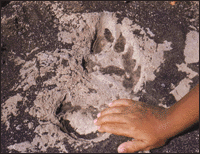Infrequent explosive activity
Explosive eruptions that deposit large volumes of pyroclastic debris over large areas -- like the May 1980 eruption of Mount St. Helens -- are rare at Hawaiian volcanoes. The term "pyroclastic" -- derived from Greek pyro (fire) and klastos (broken) -- is a general term to describe all types of fragmented new magma or old solid rock ejected during explosive eruptions. Less than 1 percent of Hawaiian eruptions have been violently explosive, based on the scarcity of pyroclastic deposits. In contrast, some volcanic chains formed along the convergent boundaries of the Earth's tectonic plates contain 90 percent or more pyroclastic material.
In 1790, a series of major explosive eruptions, which probably lasted a few days
to a few weeks, deposited a blanket of pyroclastic debris up to 30 feet thick in
and around Kilauea summit.
 �
�
A much less energetic explosive eruption took place at Halemaumau Crater in May 1924. Three months before the eruption, the long-lived lava lake in Halemaumau played actively about 150 feet below the crater rim. Beginning in February, the lake surface began to drop rapidly, and soon the lake drained entirely to expose the crater floor. Throughout March and April, the crater floor further subsided, apparently in response to magma moving from the summit reservoir into the east rift zone. By May 6, Halemaumau's floor was more than 600 feet below the rim.
